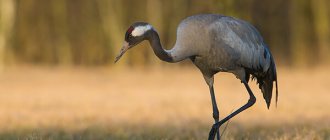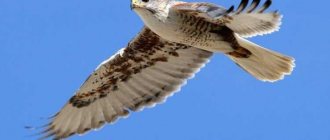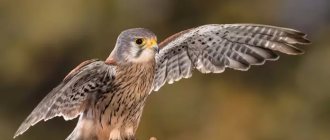Among the representatives of the crane family there are rare specimens that are disappearing from our planet. We are talking about a black crane.
These beautiful birds still cannot be studied in detail by science, but ornithologists still managed to find out something about them. Let's try to take a closer look at these sophisticated birds.
Black-billed crane (Grus monacha).
Appearance of the black crane bird
The black crane is the smallest member of the family. The birds barely reach a height of 1 meter, while their weight does not exceed 3.5 kilograms.
Most of the body has light blue plumage. The flight feathers and tail are black, and the neck and head are white. The upper part of the head up to the eyes is not covered with feathers, the skin in this place is red. The legs are dark brown, the beak is pale yellow, distinguished by a greenish tint.
There are no external differences between the sexes, but males are slightly larger than females. In young birds, the body is covered with blue feathers with a reddish tint. And the head is covered with black and white feathers.
Black cranes are native to Asia.
Reproduction
Mating dances of cranes Mating rituals include choral songs and dances.
Males, attracting females, perform sonorous songs. When singing, males stretch their necks and lift their heads so that their beak points to the sky. During the period of spring songs they say “The cranes are trumpeting the dawn.” The ringing voices of cranes herald the coming of spring. Ritual bird dances look colorful. Mature birds run in a circle, flapping their wings and jumping funny on their stilt legs. During the dance, they make loud, sharp sounds ending in a dull consonant “rkak-kak-karrs”. From two to seven birds take part in the dance.
Habitat of black cranes
The black crane lives over a vast territory from Western Siberia to Eastern China. But this does not mean that this species fills this vast area. Individual populations occur in different parts of this large area. For example, in the summer, black cranes fly to Primorsky and Khabarovsk territories, Yakutia, and Transbaikalia. There are populations in the taiga regions of Western Siberia. Some representatives of the species are found in Northern China.
When Siberian frosts set in, birds migrate south, with most going to the southern regions of Japan. On the island of Kyushu in Kagoshima Prefecture there is a nursery called Izumi, which is chosen as a habitat for thousands of different birds in the winter.
Black crane in flight.
A small number of black cranes travel to Honshu in Hyogo Prefecture. Also for the winter, these birds fly to part of the Yangtze River basin, which flows in China and South Korea.
LiveInternetLiveInternet
The crane is a famous bird. The crane is often mentioned in fairy tales and fables, in songs and proverbs. And in general, there is probably no person who does not know this bird. Some scientists claim that this is a large group of birds, consisting of at least two hundred species; others, on the contrary, argue that this is a very small order, consisting of only 14 species; Still others in the order of cranes include macaws and trumpeters (there are only 3 species). All representatives of this family are united by their appearance. These are quite large birds, with an elongated body and long straight legs. They are distinguished by an elongated, long beak. Cranes molt 2 times a year. Moreover, all their large feathers fall out almost simultaneously. Therefore, the bird does not fly for some time after molting. Cranes are “talkative” birds and often announce their presence with cries. And at the same time, these birds are very careful. For example, during feeding, one or two birds always stand “on guard”, watch what is happening around, and in case of the slightest danger they warn the others by shouting. Cranes are constant in their affections. Once they create a couple, they do not change their affection throughout their lives. Cranes usually live in swamps, ponds, and lakes. They are found in almost all parts of the planet, except Antarctica and South America. Our country is home to seven species of cranes, of which the gray crane is the most common. The body length of this long-necked and long-legged bird is 95 - 120 cm. The wingspan is 180 - 220 cm. It weighs up to 6 kg. The color of its feathers is gray with black and white areas. In flight, the neck and legs are extended. A flying flock of birds usually looks like a wedge. They live in various natural zones from forest-tundra to deserts. They inhabit marshy areas, swampy forests, raised bogs and water meadows, from Scandinavia to Central Asia and Kolyma. Birds from Central Europe and Scandinavia winter in Spain, Portugal or North-West Africa from October to November. They are rare everywhere and require protection.
In the spring, during the current, you can watch cranes dancing near the nesting sites. At this time, the birds form small groups, jump, bow, flap their wings, run in circles, then zigzag. Gray cranes nest for the first time at the age of 4 - 6 years. This place is carefully chosen and can be used from year to year in the future. They rarely change partners and often live together for a long time. Cranes, like many birds, return from wintering to their permanent nesting sites. Usually these are swampy places overgrown with reeds, reeds, and bushes. They build nests at large distances from each other: at least five to six kilometers. The bird makes its nest in an open place: it needs visibility. There are usually two eggs in a nest, and the second egg is often 20 - 25 grams lighter than the first. Cranes incubate their eggs for 29-30 days, and the hatchlings weigh approximately 120 grams. But as soon as the chicks leave the nest - and they do this, like the children of all brood birds, having barely dried out - the parents (by the way, the father is nearby during incubation and, in case of danger, warns his wife with a cry) immediately take the cranes into the thickets. When the chicks grow up, the whole family begins to fly to other places to feed.
The photo shows a black crane's nest
Cranes feed on berries, young shoots of herbaceous plants, seeds, but do not disdain insects. After searching for food, the birds always return to their native thickets. At the end of summer - beginning of autumn, cranes begin to gather in one place to fly to their wintering areas. The gathering places are repeated from year to year. In our country they are declared nature reserves. By this time, young cranes are already quite confident in flying and can go on this long journey with their parents. In October, flocks form the famous “crane wedge” and fly away. The flight is carried out only during the day at high altitude. The leader of the flock flies ahead, towards whom all the others are guided, emitting the no less famous “crane purr”. Their beautiful, slightly sad voices are not like the ones they use to communicate. In our country, the steppe demoiselle crane (Anthropoides virgo) is rightfully considered one of the most elegant. This is the smallest species of the crane tribe - its height is 90 - 100 cm, and its weight is 2 - 3 kg. No wonder it is also called the little crane. It has an elegant build. Elongated flight feathers form something like a long “tail”. The plumage of the body is ash-gray; the neck, head and elongated craw feathers are shiny black, and on the sides of the head, tufts of thin hair-like snow-white feathers extend back from the eyes, forming a kind of “braids”. The demoiselle crane inhabits steppe and semi-desert regions of Eurasia and North Africa, preferring flat or slightly hilly areas on the plain or in the foothills with low grassy vegetation. In the European part of Russia, the distribution of belladonna has undergone repeated changes. When the steppes in the Volga region were plowed, cranes were forced to move south, into arid semi-deserts. At the end of the 20th century. The reverse process of belladonna's movement to the north began. Cranes began to develop cultivated lands for nesting and build nests on winter crops of wheat and barley. A similar phenomenon is observed in Altai. In Kalmykia, on the contrary, belladonnas choose exclusively unplowed fields. In summer, belladonnas feed mainly on animals (insects, lizards, and can eat the eggs of birds nesting on the ground). Their diet also includes seeds and other plant parts. At the end of summer, birds willingly feed in grain fields, and these cranes, tearing off the ears of corn, swallow them whole. The flight of demoiselle cranes is direct, light and graceful; flocks often form a wedge. The belladonna's voice is a high-pitched and creaky purr, more creaky than that of the gray cranes. Compared to other cranes, belladonna cranes are less cautious and will allow humans to get quite close and can even get along well with them. In Mongolia, where these cranes have never been hunted, they often appear on the outskirts of villages, wander among yurts and even bring their chicks to water. The number of demoiselle cranes in this country is quite high. The crane's nest is simple. They can serve as a small depression in the ground, or a flat area lined with pebbles or dry sheep droppings. Although the eggs (2-3 in a clutch) are located completely open on the ground, they are very difficult to notice due to their camouflage coloring. The incubating bird behaves cautiously. When in danger, it secretly leaves the nest and takes off at a considerable distance from it. The hatched chicks are covered with thick down and can move independently in the first hours of life. Crane families with chicks lead a wandering lifestyle. During the day they feed in the steppe or meadows, and in the evening they can be found on grain crops. The number of nesting belladonna belladonnas in Kalmykia is 15 - 16 thousand pairs, in Altai, Tyva and Transbaikalia - up to 3 thousand. Demoiselle belladonna is protected in the Daursky and Khakassky reserves, Stepnoy (Kalmykia) and Toreysky (Transbaikalia) reserves. The first experience of artificial breeding of belladonna in our country was obtained in the crane nursery of the Oksky Nature Reserve and the Moscow Zoo. Listed in Appendix II of the CITES Convention. The mating “dances” of demoiselle cranes are similar to the “dances” of gray cranes, but demoiselles are more silent. Their “dances” consist of running with raised wings, bowing and tossing tufts of grass with their beaks. From year to year, mating “dances” take place in the same places. “Dancer competitions” last for several hours in a row. They are most active in the evening and early morning hours. Another famous crane is the Siberian Crane. The Siberian Crane (Gms leucogerimiis) is a large (body weight 5 - 8 kg, height up to 140 cm, wingspan up to 260 cm), gracefully built crane. The predominant color is white, which is why the Siberian Crane is also called the white crane. The front of the head, beak and legs are red. Young Siberian Cranes have a reddish-ocher color, but the ends of their wings, like those of adult birds, are black. The flight of Siberian Cranes is calm and straightforward, taking off from the ground with a short run-up. Siberian cranes nest on the marshy shores of lakes in swampy tundra and forest-tundra. Sedge and other vegetation are used to build nests. The clutch consists of one or two large greenish eggs (the weight of one egg reaches 200 g). The female incubates the clutch, and the male acts as a guard. Only one, the eldest chick, survives in the nest. The youngest, as a rule, dies. Siberian cranes are silent near nests. Extreme caution and open terrain make this crane inaccessible to humans. The great white bird can be seen at a distance of 1.5 - 2 km. However, at the same, if not greater, distance, the Siberian Crane also notices a person. The male gives an alarm call and takes off. The female, bending down, leaves the nest and rises on the wing far from the clutch. The “dancing” of white cranes consists of high jumps with outstretched wings, figure eight runs and turns. "Dances" can be performed by a single bird or a pair. The vocal “duet” of the Siberian Cranes is a very melodic and short cry “li-a-a-a... li-a-a-a...”, which in good weather can be heard 800 - 1000 m away. Siberian Cranes prefer plant foods (rhizomes of sedges and cereals ), on occasion they do not refuse insects, mollusks and small rodents. In nature, the Siberian Crane has almost no enemies. Wild reindeer can have an indirect influence on the reproduction of cranes. In those years when spring is late, the timing of migration of deer and incubation of clutches of Siberian Cranes coincide. Passing flocks disturb the cranes, and they leave the nests. Clutches can also be destroyed by large seagulls. For the same reason, grazing of domestic reindeer in these areas is undesirable. Although the Yakuts consider the Siberian Crane a sacred bird and never hunt cranes, their herds of deer disturb the birds and their dogs destroy the eggs. The first information about the white crane appeared in Russia in 1762 and belongs to the Russian geographer P. I. Rychkov. Over the more than 200 years that have passed since then, the nesting area and numbers of the Siberian Crane have declined catastrophically. The nesting sites, through which we first learned about the Siberian Cranes, have disappeared due to the drying out of lakes and swamps. To date, two breeding centers for Siberian Cranes have been preserved - in North-Eastern Yakutia and Western Siberia (lower Ob). The size of the West Siberian population of Siberian Cranes is about 50 birds, the Yakut population is about 800. White cranes winter in India and China. The Siberian Crane is protected throughout the world. Included in the IUCN-96 Red List and Appendix I of the CITES Convention. Aviary breeding of Siberian Cranes is practiced in the nursery of the International Crane Foundation (USA) and the crane nursery of the Oka Nature Reserve. The protection of birds, which are not limited in their travels by state borders, requires the combined efforts of many countries. The Far East and the Amur Valley attract the attention of many Russian and international organizations involved in nature conservation. Here, in the adjacent regions of Russia and China, the nesting sites of the rare black-crowned, white-naped and red-crowned cranes, listed in the Red Data Books of the International Union for the Conservation of Birds and Russia, are concentrated. The valley of the Amur and its tributaries is densely populated by people. Meanwhile, during the nesting season, cranes - extremely cautious and timid birds - need completely deserted and, moreover, quite vast swampy spaces, since nesting cranes have an extremely negative attitude even towards the close proximity of other pairs. The Khingan Nature Reserve was created specifically for the protection of red-crowned and white-naped cranes. In order to study and protect the unique crane populations of the Amur region, an unprecedented international project has been developed with the participation of Russia, China and the United States, represented by the world-famous center for the study of cranes. Exceptional merit in preserving the crane tribe of the Amur region belongs to Japan, where all black cranes, many red-crowned and white-naped cranes spend the winter. Fortunately, in this country cranes have been revered since ancient times. Mass feeding of wintering cranes has been carried out here for more than 70 years.
The black crane (Grus monacha), or monk crane, is an inhabitant of moss swamps in the low-mountain taiga zone (200 - 700 m above sea level). Such places are rarely visited by humans and are almost untouched by economic activity. The nesting area is limited to individual “spots” located in an intermittent strip from the Central Siberian Plateau to the Sikhote-Alin. The black crane winters in the south of Korea and Japan. Despite the fact that he was described about one hundred and fifty years ago, much in his life still remains a mystery to naturalists. There is little information about its ecology and biology. Only one thing is clear: there are few of these cranes. The crane makes nests in sparse thickets of shrubby birch and larch, 50 - 150 m from open areas of the swamp. The basis of the nest is a peat-like mass, damp moss, rhizomes and reed stems. Birds collect this “building” material in the immediate vicinity of the nest, which leads to the formation of a depression around it that is filled with water. The nest protrudes 20–25 cm above the water and has a round shape. There are usually two eggs in a clutch. At nesting sites, the monk crane remains very secretive. Cranes move through the swamp carefully and silently. Before going out into open areas, they inspect them, hiding behind trees. Black cranes are silent. Their screams can only be heard at dawn. Most often, a “duet” is performed, when the female and male scream synchronously, in “one voice.” “Duet” accompanies the formation of a pair, meetings and changes of partners on the nest. Black cranes are predominantly vegetarians. Flowers and seeds of sedge, sprouts and inflorescences of cotton grass, young shoots of marsh plants form the basis of their diet throughout the summer. In August, cranes mainly switch to berries. The number of black cranes nesting in Russia is unknown. Counts at wintering grounds in Japan make it possible to estimate the global population of this crane species at approximately 11 thousand individuals. The black crane is under international protection. It is included in the IUCN-96 Red List, Appendix I of the CITES Convention and the Appendix to the Russian-Japanese Convention on the Conservation of Migratory Birds. In Russia, attempts are being made to breed black cranes in the nursery of the Oksky Nature Reserve. No less rare is another crane, which has three names: Ussuri, Manchurian and Japanese. This bird was first described in 1776. But thousands of years before that, poets and artists of the Land of the Rising Sun sang it. She was a demi-deity of the Japanese religion. There are very few Japanese cranes (tancho - that’s what the Japanese call them) left on earth: less than three hundred. Their biology has been poorly studied, as has their way of life. But we still know something (thanks, in particular, to the Soviet scientist S.V. Winter). The Japanese crane (Grus japonensis) is the largest of the cranes nesting in Russia. Its wingspan reaches 270 cm, its height is 150 - 170 cm, its weight is 7.5 - 8.5 kg (in summer). It differs from other cranes in its white body color, and from the Siberian Crane in its white wing tips, black neck and black secondary and tertiary flight feathers. In flight, a flock of red-crowned cranes forms a wedge. The Japanese crane is found along the middle and lower reaches of the Amur, in the Lake Khanka basin and along the Bikin River. The main habitats are extensive swamps and marshy meadows along river valleys and lake basins. Red-crowned cranes feed on mollusks, small fish, frogs, aquatic insects, and sometimes small rodents. In Primorye, pairs of red-crowned and white-naped cranes often settle side by side in vast sphagnum bogs. They do not have friendly feelings towards each other, and white-naped cranes sometimes have to endure undeserved insults from their taller relatives. For nests, cranes choose areas covered with tall, dry sedge and flooded with water (depth from 10 to 50 cm). The nest is a flat oval area with a very shallow tray. The clutch usually consists of two eggs, which are incubated alternately by a male and a female, replacing each other every three to four hours; at night, one sits on the eggs. It is known that these birds are very clean. “When you watch a crane majestically walking around the feeding area, it is difficult to say what he is doing more often - cleaning his plumage or collecting food,” writes S. V. Winter. Cranes are especially carefully cleaned before incubation. Red-crowned cranes are excellent parents. They greet the appearance of the chick with loud, joyful cries, become very excited, fuss, alternately warm the chicks and carry food for them. If necessary, they bravely protect their offspring even from large dogs. They really need human help and protection. And if people do not take the same decisive steps to save the Japanese crane as they did with the Siberian Crane and the American Crane, this bird will disappear from the face of the earth. And along with it, an amazing phenomenon in the life of birds - crane dances - will disappear. All the cranes are dancing - gray, belladonna, and black. Moreover, belladonnas prefer to dance collectively - all the birds nesting in the vicinity gather for the “games”. They stand in a circle, and several birds “dance” in the middle of this circle. Then the dancers join the ranks of spectators, and new ones enter the circle. The dances of other cranes are also interesting. But the Japanese still have the most amazing and unusual dances. Dancing usually begins after feeding. Before they start dancing, these cranes make drawn-out and pleasant sounds, then bow to each other, flapping their wings and begin to walk, speeding up the pace every minute. And suddenly they freeze one against the other. And then they rush again, now slowing down, now speeding up the pace. From time to time they jump, sometimes high - up to two meters. During one of the jumps, they almost press against each other, slowly gliding, and fall to the ground. After this, the dance usually stops. But it may resume again. And again the partners circle, jump, suddenly freeze, pointing their beaks upward. They circle again, pick up some chips or twigs along the way and throw them high. At the same time, every movement of the birds is full of grace and elegance. Cranes usually dance in pairs. But the dance can be both collective and “semi-collective” - the dancing couple infects other birds, and they, watching the dancers, do a few steps or also start “dancing.” Many naturalists have seen the dancing of cranes. And there was an opinion that these were mating dances, similar to the mating dances of other birds. But cranes dance not only in the spring, but at any time of the year, and not only those who are ready to start a family dance, but also young people who are too early to get married. Various assumptions were made about this, but there was no exact answer. There is still no answer, although the Soviet scientist Yu. Puchinsky believes that the spring dances of cranes are “ritualized nest-building behavior.” Yu. Puchinsky made this conclusion by observing black cranes. Black cranes build nests in swamps. But before building a nest, they must prepare the site, compact the soil, trample down plant debris and make a “foundation” for the nest. Birds do this, naturally, with their feet. From here, Yu. Puchinsky believes, crane dances were born. Perhaps in certain cases this is true. But cranes dance not only in spring. And not only sexually mature individuals dance. One American naturalist observed a five-day-old crane calf, which performed all the steps as adult cranes do them. Five days old! Moreover, this little crane not only never saw adult birds dancing, he never saw cranes at all: he was born in an incubator. So crane dances continue to be another blank spot in ornithology. The total number of red-crowned cranes in Russia is about 500 birds, of which 30 - 40 pairs nest. In China, the population of the red-crowned crane is estimated at 400, and in Japan at 350 birds. The red-crowned crane is included in the IUCN-96 Red List and Appendix I of the CITES Convention, and is protected in the Khingan Nature Reserve (Amur Region), in Japan and Korea (in wintering grounds). Aviary breeding of birds has begun in the nursery of the Oksky Nature Reserve. The white-naped crane (Grus vipio) has three permanent nesting areas in Russia: the Middle Amur region, the northeastern coast of Lake Khanka and Transbaikalia (Chita region). The wingspan of the white-naped crane is from 230 to 250 cm and the “height” is 135 - 140 cm. The flight, like that of other cranes, is straight and calm, with slow flapping of the wings. A short run-up is required for take-off. Inhabits grassy swamps, swampy meadows and reed thickets along river valleys and lake basins. The crane places its nest directly in the water or on a large hummock. It looks like a round, well-compacted area with a shallow tray. There are usually two eggs in a clutch. Birds behave very secretly near nests. After the chicks hatch, the broods stay close to the nesting site and then wander around in search of food. The number of white-naped cranes on Russian territory is extremely low - 500 - 600 pairs. The world population does not exceed 2.5 - 3 thousand individuals. The reason for the decline in the number of these birds in Russia is the drainage of swampy areas and spring fires, when fire destroys reeds and islands of dry grass along with crane nests. When wintering, white-naped cranes spend the night in swamps and shallows. Flocks that have scattered to feed gather together at dusk. Several birds take part in the dances at the same time. The dances of white-naped cranes are quite monotonous: they include high jumps with flapping wings and tossing tufts of grass with their beaks. Stories that cranes form a circle and alternately “dance” in pairs are not true. The white-naped crane is placed under international protection. It is included in the IUCN-96 Red List and Appendix I of the CITES Convention, and is included in the Russian-Japanese Convention on the Conservation of Migratory Birds. Attempts are being made at aviary breeding of white-naped cranes in the nursery of the Oka Nature Reserve and in the Moscow Zoo. The whooping white crane is a legendary bird. Not so long ago, quite widespread, it was completely destroyed and included in the lists of birds that once lived on earth. And suddenly - a sensation: in 1938, fourteen cranes were discovered. Scientists traced the path of the cranes; it turned out that they spend the winter in Texas, and in the spring they fly across America - to Canada. On flight days, radio stations along the entire route of the birds begin to broadcast special programs about white cranes; an airplane takes off from the nearest airfield and accompanies the flock. Year after year, scientists counted these birds - their number either decreased or increased slightly. A small handful of birds - the last survivors on earth - desperately fought for their existence. And although their number tripled in twenty-six years - in 1964 there were already forty-two birds - it was difficult to imagine that they would still survive. There are only four dozen: after all, if some natural disaster or major accident happens, for example, an oil spill in nesting areas, and that’s it - there will be no more cranes! And then people decided to help the birds. It was found that cranes lay two eggs, but only one chick hatches: the second egg is like a safety net; the parents will take care of it if the first chick dies. And if he survives, the egg will remain unhatched. Apparently, cranes are not able to feed and raise two chicks at once. Cranes nest in the remote swamps of Canada. But this did not stop people: a plane, a helicopter, a boat, and their own feet led ornithologists to the cherished place - to the nests of white cranes. Of course, scientists did not immediately go for it; it took several years to test, develop and think about the operation. And finally people decided: from each nest they took one egg - a “safety” one. They were urgently delivered to the biological station (from the swamps of Canada to Washington - helicopter, plane, car) - in nine hours. The eggs were placed in an incubator. And a miracle happened - little cranes were born. Now there are already several dozen of these amazing birds living on a special farm, raised from eggs that were practically doomed to death. This means that the flock of cranes is now growing much faster, which means that the white whooping crane has a chance to survive and remain on our planet. The story of the Siberian Crane is even more telling. These birds are also very rare; they nest in the lower reaches of the Ob and in Yakutia, and winter in India and Iran. The path of these birds to wintering grounds and to their homeland is at least 5.5 thousand kilometers one way. Many dangers await birds on their way, and it is not surprising that their number is constantly decreasing. People decided to save the Siberian Cranes. Siberian cranes also have two eggs in their nest. And the same thing - “backup”. This means that it can be taken away... Theoretically, of course, it is possible. But practically how to do this if it is difficult to see not only the nest, but also the adult bird. It is not for nothing that the Yakuts have long had a belief: happiness awaits a person who meets a Siberian Crane. But happiness doesn’t happen every day; it happens that a person waits all his life for his own happiness, but never gets it. But although it was rare, very rare, people did meet adult birds. As for the nests, two decades ago no one had seen them at all. The famous Russian traveler Peter Pallas, who first described this crane in 1773, did not see the nest of the Siberian Crane, nor did other travelers and zoologists see it, although they were looking for these nests. For almost two hundred years, people searched for the nests of the Siberian Crane, but they could not find the nests themselves, the eggs, or the chicks. They couldn't even find egg shells! And only in 1963, Professor K. A. Vorobyov - the first of the scientists - saw the nest and chicks of this bird. It is difficult to get to the Siberian Crane nest in the Yakut tundra, very difficult, even if it has already been found. But first you need to find it - a small dot in the endless swamps of the tundra. However, no difficulties stop enthusiasts. And so a group of scientists led by Doctor of Biological Sciences V.E. Flint sets out on a search. The expedition ended successfully - nests of Siberian Cranes were found and precious eggs were obtained. Now scientists needed to find a way to hatch chicks from these eggs. We decided to place Siberian Crane eggs in the nests of gray cranes: after careful and painstaking work, it was established that gray cranes spend the winter in the Middle East, in a well-protected area. This is extremely important, especially when the bird is very rare. Scientists decided to “send” young Siberian Cranes for this wintering, which would emerge from the eggs placed on the gray cranes. Young Siberian Cranes would probably fly away for the winter with their foster parents. Everything was thought out, even specific adoptive parents were identified - gray cranes nesting in the Oksky Nature Reserve near Ryazan. But the trouble was that the Siberian Cranes lay eggs much later than the Gray Cranes: when the Siberian Cranes just sit down to incubate, the Gray Cranes already have quite grown chicks. Of course, in this case, the adoptive parents will not incubate other people's eggs. Scientists have outlined a different path - they decided to send the Siberian Crane eggs to the International Foundation for the Conservation of Cranes, to its Reproduction Center located in the USA, in the state of Wisconsin. The meaning of this operation is as follows: in the Reproduction Center, the Siberian Cranes will be hatched from the eggs received in incubators. Then, when the birds grow up, by changing the length of daylight hours, temperature, humidity and other conditions important for the birds (this is possible in the Reproduction Center), they will begin to be “accustomed” or “persuaded” to change the timing of egg laying, to coincide with the laying timing of gray cranes. And in three years, when the birds begin to lay eggs “on time,” bring these eggs to our country and place them in the nests of gray cranes. This event is one of many included in the international cooperation program in the field of environmental protection. And now the “operation Siberian Crane” has been carried out. Long days of waiting and observing birds in the tundra, then a helicopter, a plane. Aerodrome in Moscow. A car is already waiting at the airport. She rushes to another airfield with a precious cargo - four Siberian Crane eggs, placed in a special thermostat, where a certain temperature is maintained. Plane Moscow - London and then to the USA. It was necessary for the Siberian Crane eggs from the Yakut tundra to reach the state of Wisconsin no later than 48 hours later. And they, having “flown” 10 thousand kilometers, not only “met” the deadline, but even arrived “ahead of schedule” - in 42 hours. And two weeks later a telegram: two little Siberian Cranes were born. Just two... Two birds... How few, considering that for a species to survive in nature, at least several hundred are needed. And how much is this, considering that human will, energy, and reason performed a miracle - they outlined the path to saving the rarest birds.
Pictured below is the Crowned Crane.
Source: https://www.zoodrug.ru/s/ZHuravli.html
Lifestyle and nutrition of the black crane
Black cranes feed on plant and animal foods. These birds prefer aquatic plants, but they also feed on berries, grains and seeds. The diet includes frogs, insects, and small rodents.
Black cranes feel great in nurseries where they spend the winter with other birds.
Birds have chosen areas with sparse vegetation; they are not found in forest thickets and covered spaces. During winter migration, black cranes form large flocks.
Tags
All questions of the project on questions Similar questions to questions Questions Current questions theory ask questions. questions asked of each question are given Questions to viewers Children's project Kindergartens and children's organizations and children in the region. Children prepared an exhibition of children's works...
questions children fly away what games tit cuckoo theme winter tests competition crows crossbill sparrow nature negir world of classes answers teams magpies nightingale fashion event heat children 's all languages classes school will be a bird work student site leading forest courses guys assignments
Number
Black cranes are birds listed in the Red Book.
In 2006, the population numbered 6,900 mature individuals. Today the number of black cranes has increased to 11,600 individuals. These data were made in winter, when birds gather in large groups in Korea, Japan and China.
It is worth noting that the risk of extinction of the population is low, since nesting sites for black cranes are found far away from human activity. In winter, these birds also live in favorable conditions. But in the Yangtze River basin in China, there is a threat of extermination of these birds, as dam construction work is regularly carried out there, which has a negative impact on the marshy areas.
Since the population size is small, the black crane is listed in the Red Book and today measures are being developed to protect these beautiful winged creatures.
If you find an error, please select a piece of text and press Ctrl+Enter.
Spreading
Most of the black-necked crane population lives in the western Chinese province of Qinghai (Tibetan Plateau) at an altitude of 3800–4500 m above sea level. A small population is found in the adjacent Indian region of Ladakh.
The main habitats of the species are wetlands along the banks of mountain rivers and lakes.











